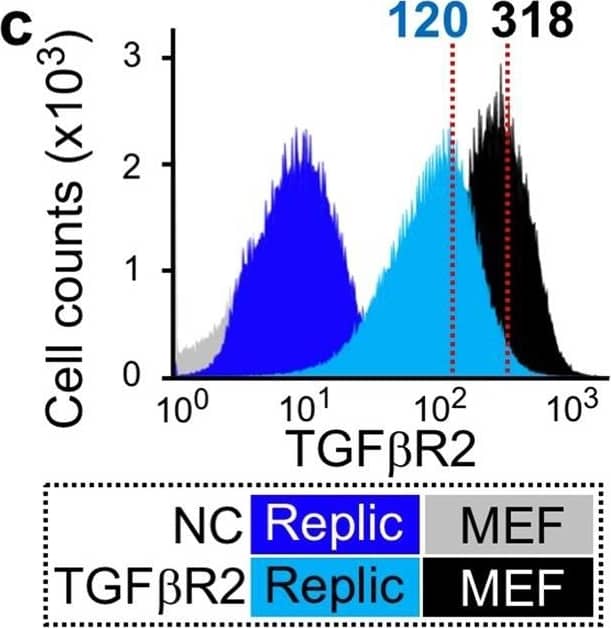Mouse TGF-beta RII Biotinylated Antibody
R&D Systems, part of Bio-Techne | Catalog # BAF532

Key Product Details
Validated by
Species Reactivity
Validated:
Cited:
Applications
Validated:
Cited:
Label
Antibody Source
Product Specifications
Immunogen
Ile24-Asp184
Accession # Q62312
Specificity
Clonality
Host
Isotype
Scientific Data Images for Mouse TGF-beta RII Biotinylated Antibody
Detection of Mouse TGF-beta RII by Flow Cytometry
Myofibroblastic property of Replic cells. (a) mRNA expression levels of genes related to myofibroblasts in Replic cells cultured with MSCM. In addition to MEFs cultured with DMEM, injured and contralateral kidneys (n = 3 for each) of UUO-treated normal mice were compared to Replic cells with respect to mRNA expression. Twelve biologically independent samples for each cell line were analysed. (b) mRNA expression levels of genes for TGF beta superfamily receptors in Replic cells cultured with MSCM were compared to those in mouse kidneys (n = 3 for ISAM-REC kidneys and WT kidneys) and MEFs. Six biologically independent samples for each cell line were analysed. (c) Flow cytometry of TGF betaR2 expression on the cell surface of Replic cells and MEFs cultured with DMEM. Negative controls (NC) were stained only with APC-conjugated streptavidin. The mean fluorescent intensities are shown (red dotted lines). (d) mRNA expression levels of genes related to myofibroblasts in Replic cells cultured with DMEM or MSCM. Six biologically independent samples for each cell line were analysed. The average expression levels of injured kidneys (a), ISAM-REC kidneys (b), or Replic cells cultured with DMEM (d) were set at 1.0. Error bars are indicated standard errors, and arrows indicate undetectable levels (a,b). *p < 0.05 and **p < 0.01 by multiple comparisons using one-way ANOVA with Tukey-Kramer tests (a,b) or by two-tailed, unpaired Student’s t-tests (d). Image collected and cropped by CiteAb from the following publication (https://pubmed.ncbi.nlm.nih.gov/31375751), licensed under a CC-BY license. Not internally tested by R&D Systems.Applications for Mouse TGF-beta RII Biotinylated Antibody
Flow Cytometry
Sample: Mouse splenocytes
Western Blot
Sample: Recombinant Mouse TGF-beta RII Fc Chimera (Catalog # 1600-R2)
Formulation, Preparation, and Storage
Purification
Reconstitution
Formulation
Shipping
Stability & Storage
- 12 months from date of receipt, -20 to -70 °C as supplied.
- 1 month, 2 to 8 °C under sterile conditions after reconstitution.
- 6 months, -20 to -70 °C under sterile conditions after reconstitution.
Background: TGF-beta RII
Most cell types express three sizes of receptors for TGF-beta. These are designated Type I (53 kDa), Type II (70 - 85 kDa), and Type III (250 - 350 kDa). The Type III receptor, a proteoglycan that exists in membrane-bound and soluble forms, binds TGF-beta 1, TGF-beta 2, and TGF-beta 3 but does not appear to be involved in signal transduction. The Type II receptor is a membrane-bound serine/threonine kinase that binds TGF-beta 1 and TGF-beta 3 with high affinity and TGF-beta 2 with a much lower affinity. The Type I receptor is also a membrane-bound serine/threonine kinase that apparently requires the presence of the Type II receptor to bind TGF-beta. Evidence suggests that signal transduction requires the cytoplasmic domains of both the Type I and Type II receptors (1).
The recombinant soluble TGF-beta Type II receptor is capable of binding TGF-beta 1, TGF-beta 3, and TGF-beta 5 with sufficient affinity to act as an inhibitor of these isoforms at high concentrations. The soluble receptor also binds TGF-beta 2, but with an affinity at least two orders of magnitude lower. Binding of TGF-beta 1, TGF-beta 3, and TGF-beta 5 to the soluble TGF-beta Type II receptor can also be demonstrated by using the soluble receptor as a capture agent on ELISA plates and this observation has been used as the basis for the development of immunoassays for these isoforms of TGF-beta.
References
- Miyazono, K. et al. (1994) Adv. in Immunol. 55:181.
Long Name
Alternate Names
Gene Symbol
UniProt
Additional TGF-beta RII Products
Product Documents for Mouse TGF-beta RII Biotinylated Antibody
Product Specific Notices for Mouse TGF-beta RII Biotinylated Antibody
For research use only
